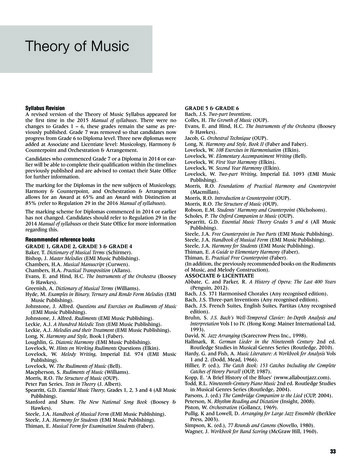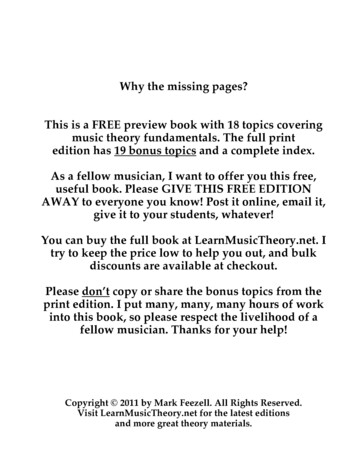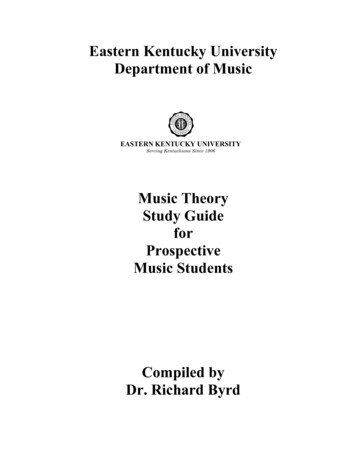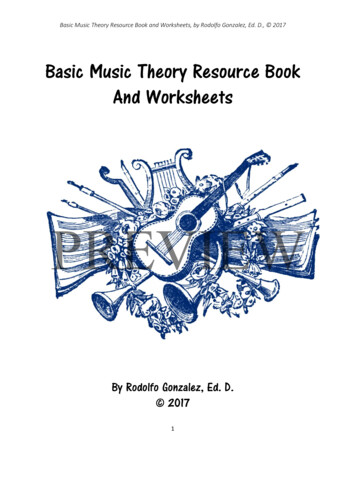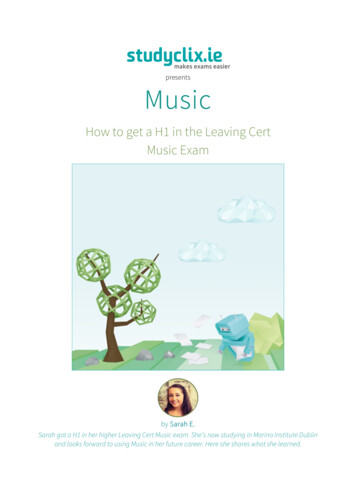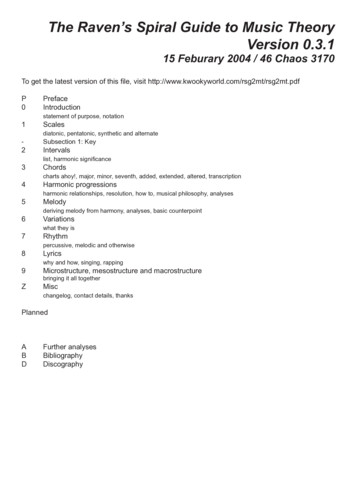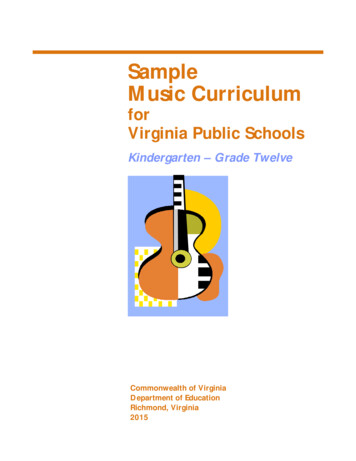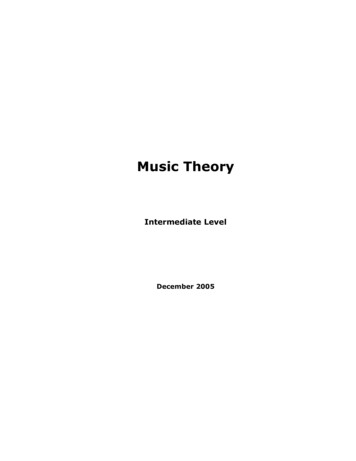
Transcription
Music TheoryIntermediate LevelDecember 2005
Introduction . 3Target Notes . 4Theory. 4Characteristic Notes . 4Phrasing. 5Usage . 6Chord Progressions and Tonality. 8Theory. 8Diatonic Progressions . 8Chord families . 9The role of the bass . 11Non-diatonic progressions . 11Dominant Substitutions. 12Usage . 13Chord migration . 13Melodic Movements . 15Theory. 15Recommended Movements . 15Forbidden Movements . 15Tolerated Movements . 16Usage . 16Diminished and Augmented Chords . 17How to build them. 17Augmented chords . 20Pentatonic and Blues Scales. 21Theory. 21Pentatonic Major Scales . 21Pentatonic Minor Scale . 21Blues Scales. 22Dominant 7th Pentatonic Scales. 23Usage . 24The CAGED system . 252
IntroductionThis document is part of a compilation of a series of threads that deal with music theory and thatwere originally published by Eowyn on www.mysongbook.com. The compilation has beenreorganized into three separate documents: Basic Music Theory Intermediate Music Theory – this document Advanced Music TheoryThis has been done for two reasons:1. The size of one single file was too large for download2. The material covered by the different topics is of varying levels of complexity andtargets different audiences.The text of the original threads has been modified and/or extended in several places where it wasdeemed appropriate for increased readability. The rather crude layout of the original text (due tothe limitation of the forum) has also been improved. Finally, the text has been proof-read byArnold and Blackiel.This is by no means an exhaustive treatise about music theory and harmony. Much moremodestly, the purpose of this series of topics is to give those willing to better understand what theyare doing with their guitar, the ability to get this knowledge into a quick and concise form. Theunderlying objective is lead work and improvisation in a rock music context (broadly speaking), butmost topics are of a more general nature and they can also easily be adapted to other musicalgenres.There are numerous books and web sites about general music theory and more specialised topics.Interested readers will find a short reference list at the end of the document.Copyright NoticeThe information contained in this document and this document itself can be freely downloaded,used and copied for private educational purposes only. Selling of this document is strictlyprohibited in all circumstances.3
Target NotesI like to define improvisation as "instantaneous composition". In order to create a good solo ithelps to be a good composer, with all the implied musical skills; but additionally you must be ableto act on the spot in front of an audience – despite the stage fright and the stress!Those who have tried it know that this is far from easy, and poses two related challenges: Select the right notes at the right moment Play as musically and meaningfully as possibleMusic is and remains an art, and the theory is only there to acknowledge and establish what seemsto work well. The rules are only there to provide guidance; in many cases they can be broken. Butguidance is useful when you learn something new. And improvisation can be learned!I have broken down the theoretical aspects in three topics: In this topic we will address the problem of selecting the target notes of the solo based onthe chord progression. In the next topic we will explore chord progressions themselves. In the topic after that we’ll discuss the general “rules” regarding melodic movements.TheorySome solos are purely rhythmic and chord oriented. In most cases however, the lead player isexpected to create a melodic composition that blends with the harmonic structure of the piece ofmusic currently played by the band. This might be called constrained composition. When you arecomposing a piece of music, you are of course totally free to pick any harmony you want. As alead guitarist, however, you will have to make do with the chord progression currently played bythe band. The notes of the lead lines will inevitably interact with the chords played by thebackground and we want to make sure this interaction is as smooth and musical as possible.Fundamentally, this boil down to two separate but related aspects: Note selection (characteristic notes) PhrasingCharacteristic NotesThe characteristic notes of a chord are the notes that help uniquely identify and characterise thatchord (hence the name). You will recall that chords are usually build by stacking up thirds, so thecharacteristic notes of the chord are the notes 1, 3, 5, 7, 9, etc., where the third and the seventhcan be minor or major, the fifth can be perfect, augmented or diminished, and so forth.The root of the chord is a neutral tone. It is neutral because it remains the same in a very largenumber of chords: C, Cm, C7, Cmaj7, Cm7 all have the same root note C. The root does notcharacterise the chord very well.The 5th in the chord is called a second-order characteristic note; it is less uniform than the root,but still pretty stable across different types of chords. All the chords mentioned previously actually
share the same 5th (G) in addition to sharing the same root. But there are certainly C chords witha different fifth: Caug (C,E,G#) and Cm(b5) (C,Eb,Gb) are examples.The 3rd and 7th in a chord are the first-order characteristic notes of the chord; they give the chordits colour. The third immediately tells whether the chord is major or minor, while the seventh addsa lot of colour and accounts for totally different functions in the harmony. As we will see shortly,these notes play a fundamental role in improvisation.Higher order chord extensions such as the 9th (not to mention the 11th and 13th) are alsoconsidered first order characteristic notes, and are frequent in jazz music but you're not likely tosee them as often in rock music.PhrasingThe impact of a note in a solo not only depends on its pitch and function, but also on its placementin the bar, its rhythmic value, and the effects applied to it. This together is called "phrasing".PlacementRock music is predominantly 4/4 (four to the beat) music, so we'll focus on that. In a 4/4bar, the 1st and 3rd beats (the downbeats) are strong (although the 3rd beat is slightlyweaker than the 1st), while the 2nd and 4th beat (the upbeats) are definitely weak. Thissimply means that the 1st and 3rd beats get more emphasis than the other two beats. Youcan clearly hear that if you listen to a typical percussion track: bass drum on the 1st and 3rdbeats, snare on the 2nd and 4th beats.In ¾, the first note of the bar is strong, while the other two are weak.The general rule when soloing is to place characteristic notes on the strong beatsof the bar. These become your target notes.In other words, the theory requires you to try and place the 3rd or the 7th of the underlyingchord on the downbeats, or else the 5th or the root. In rock music, you will typically(although not systematically) avoid the 9th and higher order extensions.In practice, you will want to handle the 7th with care: the major 7th may sound too jazzy,and the minor 7th may require an unwanted resolution (see next topic). On the other hand,the root, 3rd and 5th always sound right.Rhythmic ValueIf a bump note is an 8th note or a 16th note, it will cause less aural damage than if it's alonger note, because it will resolve very quickly in harmonically more acceptable soundsand go almost unnoticed. Therefore, the rule above is of high importance for quarter notes and longer, andslightly more flexible for short notes (8th notes and faster).5
Also, strictly speaking the rule above is only valid when the notes are within aninterval of two octaves; beyond that, the distance becomes too large for the ear tobe sensitive to the relationship between the notes.However, if you’re not yet a seasoned lead guitarist I strongly recommend sticking to therule, even for short duration notes and high pitches.A very effective trick when you’re not sure about the target notes is to start your musicalphrases slightly after the downbeats, or downright on the upbeats. For example, whenusing 8th notes, you may decide to start on the second half of the first beat, or on the firstupbeat. Even if the first note you play is off, its impact will be much less dramatic due toits more favourable position in the bar. Moreover, this technique produces a very drivingeffect. It is very commonly used in blues.EffectsWe guitarists are happy to have several fretting-hand and picking-hand effects at ourdisposal: slides, hammers, pull-offs, bends, rakes, harmonics, muting, tapping, you nameit!Again, applying effects on characteristic notes will dramatically enhance their role andimportance. But beware of clichés.UsageGranted, a solo should ideally flow naturally as an instant composition. You “think” the melody youwant to play, and here it comes on the fret board But as you will probably acknowledge if youhave tried it, there is quite a distance between your brain and your fingers. Everybody needs tolearn, so it will do no harm constructing your solo on the principles mentioned above. Fluencycomes with practice.In general, when you're asked to play lead in a chorus:1. Quickly analyse the harmonic progression (the chords you need to play over), and identifytheir characteristic notes. For mainstream rock music, you will probably want to stick withthe root, 5th and 3rd of the chords, and only use 7th (especially major 7th) sparingly. Othergenres will have their own stylistic requirements and opportunities.2. Mentally select the characteristic notes you will play, and place them on the strong beats;this sequence of target notes becomes the melodic backbone of your solo. Try to locateand visualise those target notes on the fret board a little before you play them; that wayyou will always know where you are going. Don’t be discouraged if you find this hard todo: it is very hard to do and requires a lot of practice!3. Fill in the "gaps" with short connection phrases - initially try to use as few notes aspossible, and try to be consistent with
Music is and remains an art, and the theory is only there to acknowledge and establish what seems to work well. The rules are only there to provide guidance; in many cases they can be broken. But guidance is useful when you learn something new. And improvisation can be learned! I have broken down the theoretical aspects in three topics: In this topic we will address the problem of .

